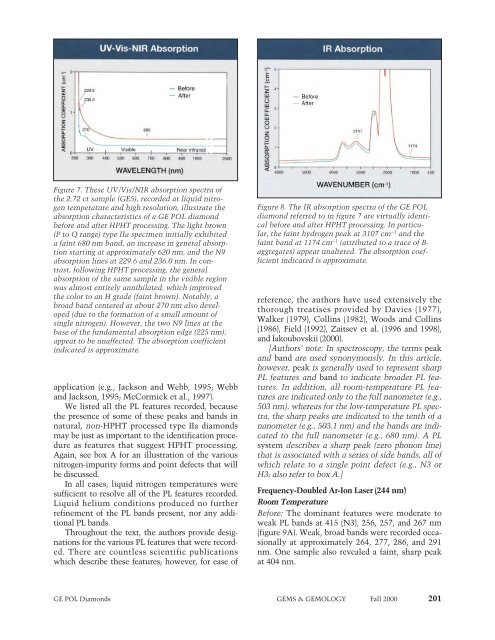Fall 2000 Gems & Gemology - Gemfrance
Fall 2000 Gems & Gemology - Gemfrance
Fall 2000 Gems & Gemology - Gemfrance
Create successful ePaper yourself
Turn your PDF publications into a flip-book with our unique Google optimized e-Paper software.
Figure 7. These UV/Vis/NIR absorption spectra of<br />
the 2.72 ct sample (GE5), recorded at liquid nitrogen<br />
temperature and high resolution, illustrate the<br />
absorption characteristics of a GE POL diamond<br />
before and after HPHT processing. The light brown<br />
(P to Q range) type IIa specimen initially exhibited<br />
a faint 680 nm band, an increase in general absorption<br />
starting at approximately 620 nm, and the N9<br />
absorption lines at 229.6 and 236.0 nm. In contrast,<br />
following HPHT processing, the general<br />
absorption of the same sample in the visible region<br />
was almost entirely annihilated, which improved<br />
the color to an H grade (faint brown). Notably, a<br />
broad band centered at about 270 nm also developed<br />
(due to the formation of a small amount of<br />
single nitrogen). However, the two N9 lines at the<br />
base of the fundamental absorption edge (225 nm),<br />
appear to be unaffected. The absorption coefficient<br />
indicated is approximate.<br />
application (e.g., Jackson and Webb, 1995; Webb<br />
and Jackson, 1995; McCormick et al., 1997).<br />
We listed all the PL features recorded, because<br />
the presence of some of these peaks and bands in<br />
natural, non-HPHT processed type IIa diamonds<br />
may be just as important to the identification procedure<br />
as features that suggest HPHT processing.<br />
Again, see box A for an illustration of the various<br />
nitrogen-impurity forms and point defects that will<br />
be discussed.<br />
In all cases, liquid nitrogen temperatures were<br />
sufficient to resolve all of the PL features recorded.<br />
Liquid helium conditions produced no further<br />
refinement of the PL bands present, nor any additional<br />
PL bands.<br />
Throughout the text, the authors provide designations<br />
for the various PL features that were recorded.<br />
There are countless scientific publications<br />
which describe these features; however, for ease of<br />
Figure 8. The IR absorption spectra of the GE POL<br />
diamond referred to in figure 7 are virtually identical<br />
before and after HPHT processing. In particular,<br />
the faint hydrogen peak at 3107 cm −1 and the<br />
faint band at 1174 cm −1 (attributed to a trace of Baggregates)<br />
appear unaltered. The absorption coefficient<br />
indicated is approximate.<br />
reference, the authors have used extensively the<br />
thorough treatises provided by Davies (1977),<br />
Walker (1979), Collins (1982), Woods and Collins<br />
(1986), Field (1992), Zaitsev et al. (1996 and 1998),<br />
and Iakoubovskii (<strong>2000</strong>).<br />
[Authors’ note: In spectroscopy, the terms peak<br />
and band are used synonymously. In this article,<br />
however, peak is generally used to represent sharp<br />
PL features and band to indicate broader PL features.<br />
In addition, all room-temperature PL features<br />
are indicated only to the full nanometer (e.g.,<br />
503 nm), whereas for the low-temperature PL spectra,<br />
the sharp peaks are indicated to the tenth of a<br />
nanometer (e.g., 503.1 nm) and the bands are indicated<br />
to the full nanometer (e.g., 680 nm). A PL<br />
system describes a sharp peak (zero phonon line)<br />
that is associated with a series of side bands, all of<br />
which relate to a single point defect (e.g., N3 or<br />
H3; also refer to box A.]<br />
Frequency-Doubled Ar-Ion Laser (244 nm)<br />
Room Temperature<br />
Before: The dominant features were moderate to<br />
weak PL bands at 415 (N3), 256, 257, and 267 nm<br />
(figure 9A). Weak, broad bands were recorded occasionally<br />
at approximately 264, 277, 286, and 291<br />
nm. One sample also revealed a faint, sharp peak<br />
at 404 nm.<br />
GE POL Diamonds GEMS & GEMOLOGY <strong>Fall</strong> <strong>2000</strong> 201


